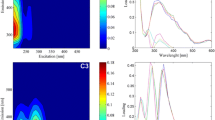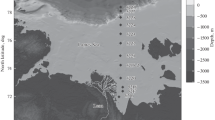Abstract
Fluorescence properties of sediment porewater humic substances collected from ten Estonian lakes with various trophy were investigated to reveal if they infer the lake’s past productivity and origin of sedimentary organic matter. The height (fluorescence intensity), location (fluorescence maximum) and shape (fluorescence index, the ratio of intensities at the emission wavelengths 450 and 500 nm) of the fluorescence emission spectrum at an excitation of 340 nm were under consideration. The study demonstrated that humic substances from sediments of eutrophic lakes were generally characterized by high fluorescence intensity and fluorescence index, and their fluorescence maximum was located at shorter wavelengths. Humic substances from sediments of oligotrophic lakes were characterized by low fluorescence intensity. Humic substances from sediments of dystrophic lakes had low fluorescence intensity and fluorescence index values, and their spectral peak was shifted to longer wavelengths. The obtained results suggest that the method has a great potential in retrospective analysis of lake ecosystems.
Access this chapter
Tax calculation will be finalised at checkout
Purchases are for personal use only
Similar content being viewed by others
References
Fellman, J.B., E. Hood, and G.M. Spencer. 2010. Fluorescence spectroscopy opens new windows into dissolved organic matter dynamics in freshwater ecosystems: A review. Limnology and Oceanography 55: 2452–2462.
Ishiwatari, R. 1985. Geochemistry of humic substances in lake sediments. In Humic substances in soil, sediment, and water: Geochemistry, isolation, and characterization, ed. G.R. Aiken, D.M. McKnight, R.L. Wershaw, and P. MacCarthy, 147–180. New York: Wiley.
McKnight, D.M., E.W. Boyer, P.K. Westerhoff, P.T. Doran, K. Kulbe, and D.T. Andersen. 2001. Spectro-fluorometric characterization of dissolved organic matter for indication of precursor organic material and aromaticity. Limnology and Oceanography 46: 38–48.
Meyers, P.A., and R. Ishiwatari. 1993. Lacustrine organic geochemistry – An overview of indicators of organic matter sources and diagenesis in lake sediments. Organic Geochemistry 20: 867–900.
Author information
Authors and Affiliations
Corresponding author
Editor information
Editors and Affiliations
Rights and permissions
Copyright information
© 2013 Zhejiang University Press and Springer Science+Business Media Dordrecht
About this paper
Cite this paper
Leeben, A. (2013). Applicability of Fluorescence Analysis of Sedimentary Porewater Humic Substances for Reconstructing Past Lake Conditions. In: Xu, J., Wu, J., He, Y. (eds) Functions of Natural Organic Matter in Changing Environment. Springer, Dordrecht. https://doi.org/10.1007/978-94-007-5634-2_169
Download citation
DOI: https://doi.org/10.1007/978-94-007-5634-2_169
Published:
Publisher Name: Springer, Dordrecht
Print ISBN: 978-94-007-5633-5
Online ISBN: 978-94-007-5634-2
eBook Packages: Earth and Environmental ScienceEarth and Environmental Science (R0)




